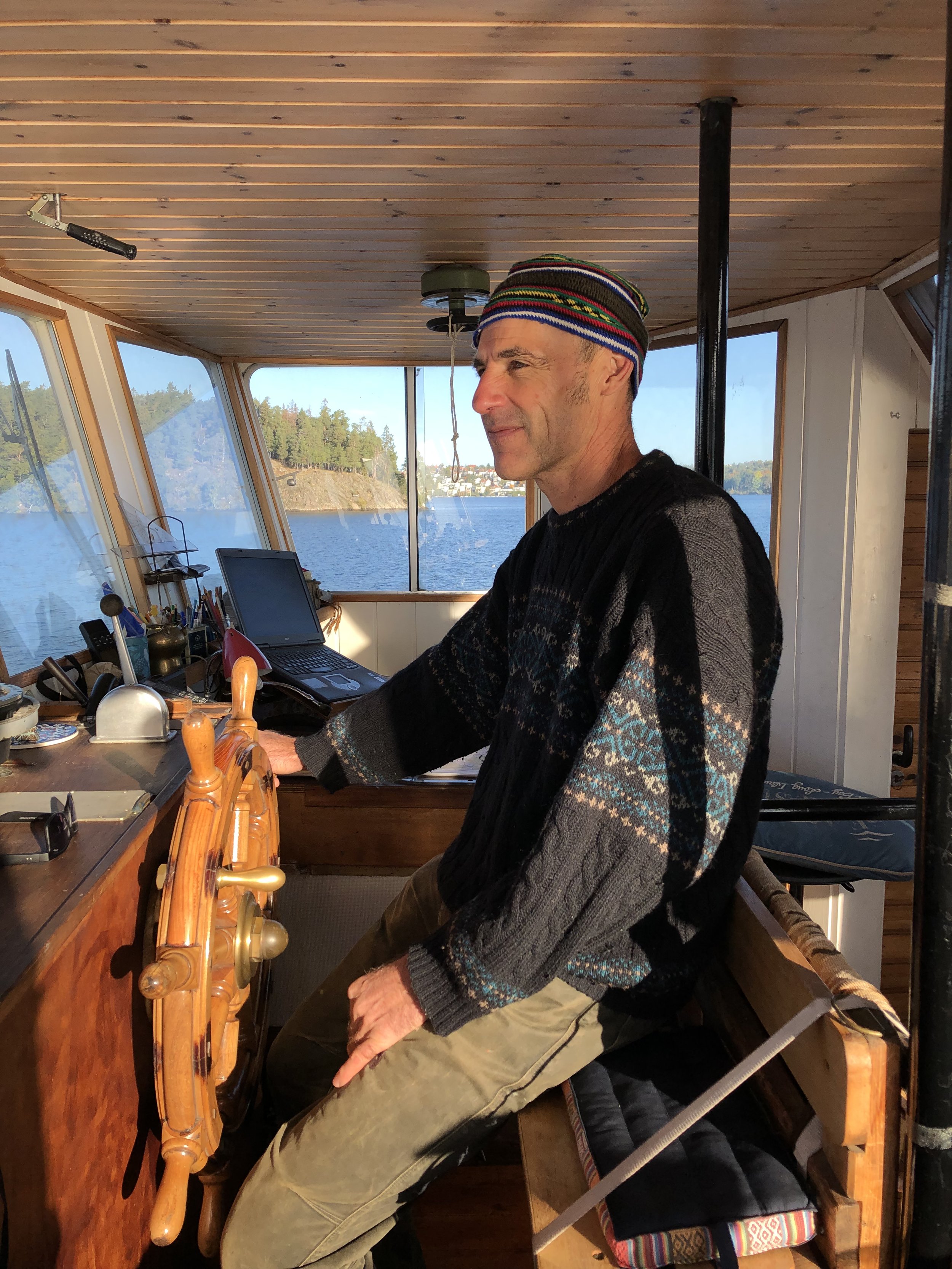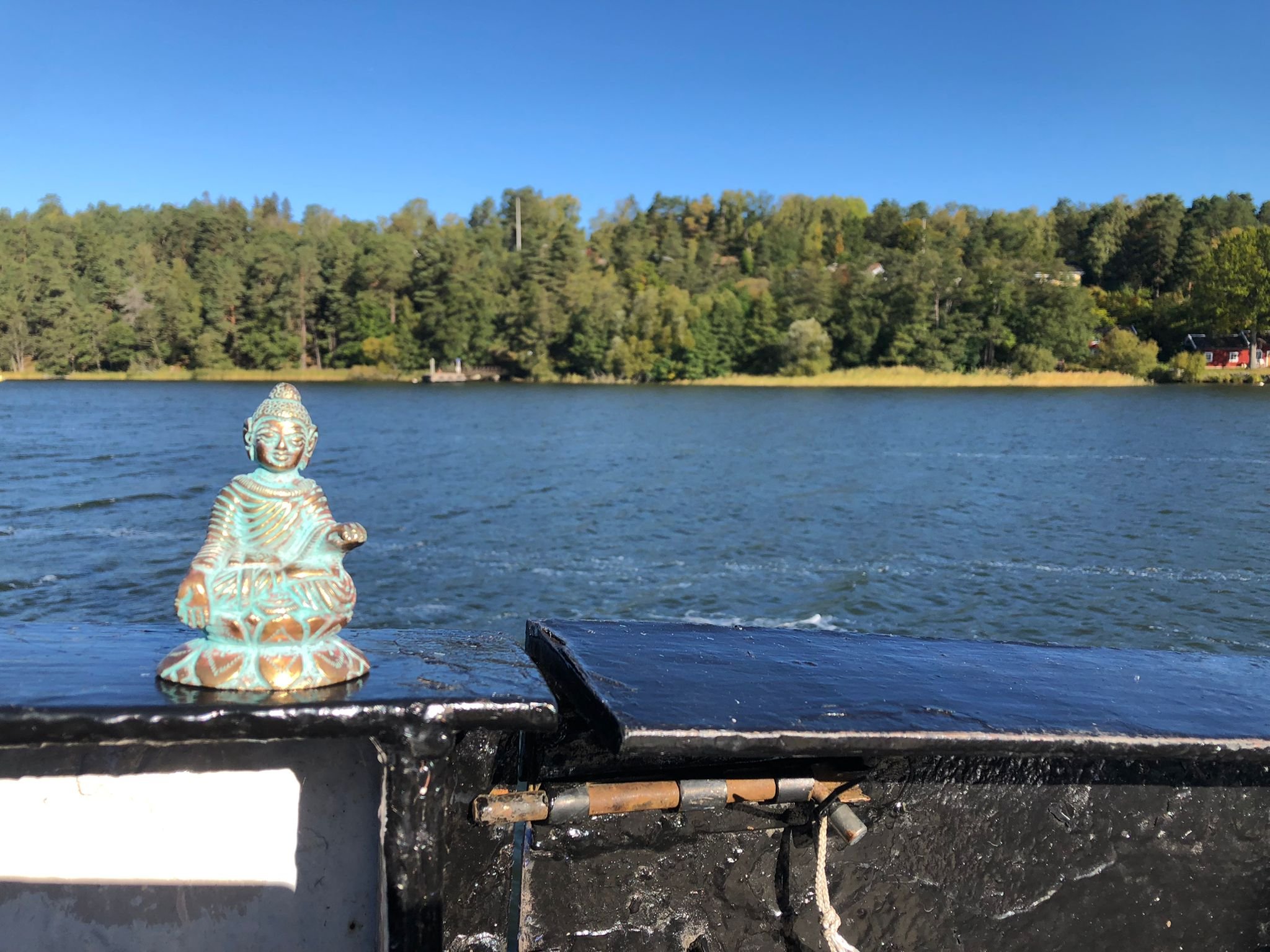Birka - the Viking Trading Town
As a preparation for the trip to Birka, Hjernet needed one of her regular maintenance sessions at the Beckholmen dry dock in central Stockholm, just a short distance across the water from her mooring place at Skeppsholmen. Treatment and painting of the underwater surfaces of the boat was undertaken during the third week of August. After Jac and I had inspected the completed work, done to a high quality, we enjoyed lunch at a nearby restaurant on Djurgården, part of the Royal National City Park, established in 1995.
Shortly after seven in the morning on the last weekend that Birka would remain open for the tourist season, Hjernet left Skeppsholmen for a day’s outing there. The weather gods had cooperated and the rain overnight from heavy clouds gave way to a glorious clear blue autumn sky and bright sun rise that highlighted the skyline of Södermalm. The large red and white Viking Line ferry to Mariehamn, Åland left Stockholm just in front of us as we approached the Hammarby lock, where Hjernet would be lifted to the water level of Lake Mälaren.
Jac - Captain of the ship at the wheel
The average height difference between the Baltic Sea and Mälaren is 66 centimetres, explained the Stockholm Harbour staff, who helped us through the lock. The water level in the Baltic Sea fluctuates depending on the tide and air pressure. During the Viking age there was no difference in water levels as Lake Mälaren was an arm of the Baltic Sea. The journey from Stockholm to Birka, about 20 nautical miles, could be covered in about two hours by the typical local Viking boats under sail.
Mid-morning, the wind picked up and we experienced a head wind of six knots and waves in open waters that gently swayed Hjernet. We passed just west of Helgö, covered in lush vegetation. Many beautiful summer houses were dotted along the shoreline. Small white clouds like wads of cotton appeared in the sky as Hjernet made steady progress towards our destination.
Passing the island of Helgö, where the Helgö Buddha was found in 1956
After a four-hour journey through a beautiful water landscape lined with trees in early autumn colours of yellow and orange, we docked at a sturdy concrete pier just a few metres from where Birka harbour would have been located. This is truly historical territory. As we disembarked, one of the few permanent residents of Björkö was dropped off at the pier by a small boat servicing the islands of Lake Mälaren, with his shopping bags from the nearest grocery store. He promptly jumped on his quad bike, the predominant means of transport on Björkö, and set off down a small dirt track.
Birka was a prominent Viking settlement and trading centre on the island of Björkö, in Lake Mälaren, west of Stockholm. Some refer to Birka as the first town of Sweden and it had a population of around 700 to 1,000 during its peak. It was established in the year 750 and was occupied until around 975 when it was abandoned. One possible reason for this could be that trade was shifted to Sigtuna, the first capital of Sweden, located in the northern part of Lake Mälaren. Helgö preceeded Birka as a dominant trading centre in the Lake but its importance gradually declined after Birka was established. Birka was a dense settlement surrounded by a protective wall with a wooden, half circle palisade open to the water. A small harbour with wharfs and jetties had been constructed on the water side to facilitate access to Birka by the Viking ships.
A wooden model of the trading town of Birka at the Birka Museum
On the mountain above the town, a fortress with wooden palisades was constructed, giving clear views of the surrounding land in all directions, which allowed spotting of any ship approaching. As the population of the town grew, Birka became crowded and without proper sanitary and waste facilities, which meant that diseases spread easily.
Initially trade with the European trading network dominated, including towns such as Hedeby in current Germany, just over the border from Denmark. From the ninth century, trade with the Baltic Sea settlements were gradually replaced by more distant trading centres such as Baghdad, Bukhara and Samarkand on the Silk Road reached via the Russian rivers, such as Volga. Silk from China, precious stones from India and silver from the Kalifate based in Baghdad, were in high demand. In return furs, honey and amber were some of the goods that were exchanged. Slavery was another important part of trade at Birka. Most of the coins in Birka originated from places such as Baghdad, Samarkand and Tashkent. Birka was also a producer of metal handicraft and textiles goods, which were also exported.
We had arrived just in time to join a guided tour of Birka in English. A group of around 40 tourists from a range of countries followed a knowledgeable guide dressed in a Viking era outfit around the island of Björkö. He explained that about 3,000 graves from the Viking period had been found on the island. Assuming an average of three bodies in each grave, it means around 9,000 individuals had been buried during the 220 years of Birka’s existence. Several of the bodies came from other places such as Hedeby in current northern Germany and lands across the Baltic sea such as the Baltic states, Russia and Ukraine. This demonstrated the interconnectedness of Birka and the extent of travel and trade. In 24 hours a Viking boat from Lake Mälaren could reach the southern Baltic Sea. The smaller boats, like Viksbåten, had a top speed of nine knots and the warships could move at a speed of 15 knots. The Viking ships could be rowed at speeds between four and six knots depending on the size and the number of oarsmen.
Through the extensive trade contacts, the people of Birka were also exposed to other religions such as Judaism and Islam. The first attempt to introduce Christianity to the Birka population was made by the Benedictine monk and missionary Ansgar around 829/830, which was not entirely successful. A wooden church he built was burnt down once he had returned to Germany. In 1834, the monument “the Cross of Ansgar” made of stone, was erected at the highest point of the island, to commemorate a thousand years since Ansgar first visited Birka.
An inter-faith meeting - the Ansgar Cross and the Helgö Buddha
The views in all directions from the top of the hill are simply magnificent. To the north-west is the island of Adelsö and the settlement Hovgården, which was home to the king. The area includes three royal mounds, which have not been excavated, and many rune stones. The UNESCO World Heritage Site inscribed in 1993, comprises both Birka and Hovgården.
The crew on top of the hill
The Birka Museum, housed in a wooden building, has recently added a section that describes the graves of two women and two men. Analysis of the remains has given clues as to their lifestyle when alive. The most interesting and intriguing one is that of a female warrior. She was buried with weapons like a sword, arrowheads, a strategic board game and two horses representing her life as a successful officer. This shows that not only men went on Viking journeys to faraway places. The museum also houses an impressive wooden model of Birka.
Returning to the pier, we discovered that there was another boat moored next to Hjernet on the sea side. It was an old two-masted school sailing ship, currently used for weekend trips around Mälaren for groups of people. Around 20 people disembarked to go on an exploratory walk of Birka. After the sailing ship moved off we began our return journey. Half way to Stockholm we were overtaken by the tourist boat, returning to Stockholm from Birka. To arrive in Stockholm on water is a very pleasant and peaceful experience, compared to negotiating one of the commonly occurring traffic jams on the main highways into the capital city. We passed the Gröna Lund Amusement Park on Djurgården on our right, which had just closed for the season, and arrived at Skeppsholmen in the diminishing rays of the setting sun after a spectacular and exciting 12-hour journey.




